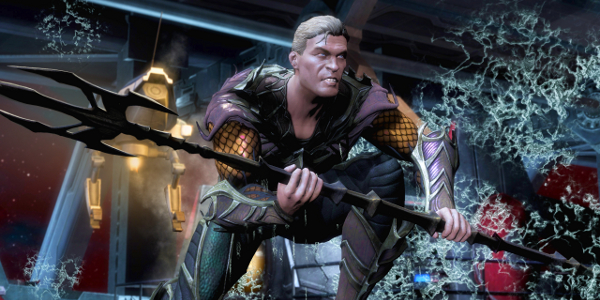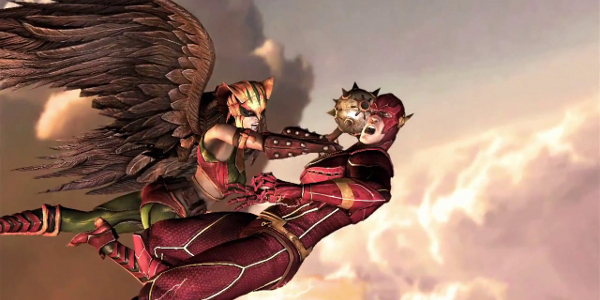I can say without a doubt that there are an infinite number of universes. Some are just like our own… but for one or two significant events, exactly the same.
These words stated by Lex Luthor introduce the story for Injustice: Gods Among Us. Published by Warner Bros. Interactive Entertainment and developed by NetherRealm Studios, who are commonly known as the creators of Mortal Kombat. The game was released across on the PlayStation 3, Wii U, and Xbox 360 on April 16, 2013, and this review is based on the Xbox 360 version of the game. Can NetherRealm studios deliver a great fighter like their Mortal Kombat reboot? Read on.
Injustice: Gods Among Us is a fighter on a 2d plane but the character models are all rendered in 3d. The roster is made up of 24 characters from the DC universe with 12 of them being heroes: Aquaman, Batman, Cyborg, Flash, Green Arrow, Green Lantern, Hawkgirl, Nightwing, Raven, Shazam, Superman and Wonder Woman; and 12 being villains: Ares, Bane, Black Adam, Catwoman, Deathstroke, Doomsday, Harley Quinn, Joker, Killer Frost, Lex Luthor, Sinestro and Solomon Grundy. Each character has their own unique feel and it’s rare for two characters to perform the same moves. The arenas are made up of various locations throughout the DC Universe like Metropolis, Wayne Manor, Gotham City, Hall of Justice, and Atlantis.
Like the Mortal Kombat reboot, the game has a lengthy story mode using the in-game models. The story of Injustice involves an alternate reality of the current universe, where Superman is tricked into killing Lois Lane and his unborn child by the Joker, which simultaneously triggers a bomb blowing up Metropolis. Deciding to do what Batman could never do, he kills the Joker in return. These actions allow him to essentially take over the world as a dictator, where anyone who opposes his view of safety and order are executed.

Most of the heroes and villains join his regime either by fear, or believing his “order” to be just and needed in the world. Those against Superman were executed, though a small few managed to elude his dictatorship, and joined the insurgency, lead by, who else, Batman.
While the story was great, NetherRealm had a chance of recreating something similar to Marvel Comic’s Civil War, where the heroes were divided based on their beliefs. In Injustice, everyone is a member of the Regime with the exception of Batman, Deathstroke, Harley Quinn and Lex Luthor. While Green Arrow and Joker have Insurgency outfits, both are dead by the time the heroes of the normal earth arrive.
Injustice controls similar to Mortal Kombat’s scheme, with a few exceptions: MK has the four face buttons assigned as front punch, front kick, back punch, and back kick; while Injustice has a light, medium, and heavy scheme, with a button assigned specifically to a “character trait.” It’s similar to Capcom’s Marvel Vs Capcom 3 layout, though combos are definitely more in line with Mortal Kombat than Capcom’s frantic fighter.
The character traits vary per character. For some, it gives them a stat boost such as strength, defense, etc.; for others, they get an extra attack, or unlock additional moves which are unusable when the trait isn’t active. For fans of Capcom or SNK fighters, inputs such as quarter circle forward can be toggled, which is a great feature, considering there are folks who aren’t fans of Mortal Kombat’s input methods.

Also unlike Mortal Kombat, blocking is done without the use of a button, but by holding back on the directional pad, which is a bit more traditional. (It also opens up a significant cross-up game.) Injustice replaces the x-ray attacks of MK with a Super Move, where characters perform an elaborate attack for huge damage, such as Superman knocking the character out of Earth’s orbit, before flying up and smashing them back down.
As stated previously, the stages of the game are all locations found in the DC universe. Each stage has items that can be interacted with, depending on the character’s classification. Power style characters like Superman usually lift and throw every item, while Gadget style characters like Batman use them differently, whether to dodge or trigger them to explode. There are also certain interactions that are universal, such as knocking the enemy to a stationary item off-screen for combos. With the exception of two stages, every stage has a transitional area where fighters are knocked through an assortment of objects–usually through building walls–that will move the fighter to a new location.
The audio for Injustice, overall, is great, though at the same time, isn’t all that memorable. Most of the characters have their iconic voices, such as Raven and Cyborg being voiced by their Teen Titans’ actors. In some situations, alternate costumes come with a different voice, such as Green Arrow, with his The Arrow alternate costume being voiced by the same actor from the television show. Music, however, just doesn’t stand out–nothing memorable for the stages, unlike the MK games, or anything iconic for that matter, like Justice League Task Force.
Injustice offers numerous modes of play to keep you well-occupied. In addition to story mode, there is Battle Mode, S.T.A.R.S. Lab, Practice, Multiplayer, and Online Mode. The Battle Mode is the equivalent of an Arcade Ladder, which is found in virtually every fighter, but Injustice has its own twist. There are numerous ladders to choose from, including Heroes Only, Villains Only, Infinite Meter, Survival, etc. It adds a bit of variety, which is a nice touch.
The S.T.A.R.S Lab takes the place of the MK challenge tower, which was loved by many. While most of the challenges require you to defeat the enemy, there’s unique goals for you to complete before doing so.

Playing online, you have a choice of traditional ranked matches, or player matches, which can be set to one vs one, king of the hill (keep playing until you lose), or survival (the same as King of the Hill, except no health regen). The online is improved over Mortal Kombat, but I have noticed instances where you are randomly desynched from a match.
For every victory or challenge completed in a mode, you gain experience. Each time you level up, you unlock items to customize your player card (named a “hero” card), as well as armor keys and access keys, used to unlock numerous bonuses, like alternate costumes, concept art, and music from the archives.
Overall, Injustice is great. There is a lot of things to keep you occupied both offline and online, and having an experience system to unlock things is fantastic, especially considering how much one had to grind in Mortal Kombat to unlock bonuses. Injustice has a simple learning curve, so anyone can pick a hero and go to work. The roster has a good balance of heroes and villains, but there is one omission that bothers me. Darkseid, who was the DC villain in MKvsDC, is the only character not to return. Yes, he is in a stage transition, but that isn’t good enough for Darkseid. The decision is up there with M.Bison being excluded as a villain for Marvel vs Capcom 3. Also, many might be upset at the amount of content that comes from the Batman universe, but considering what happens in the story, it is explanatory. Outside of my issues with Darkseid, background themes, and the occasional desynching, Injustice is a great game, and has enough new ideas to pave the way to an evolution for the fighter genre, as it’s one of the few genres that hasn’t updated its formula.
